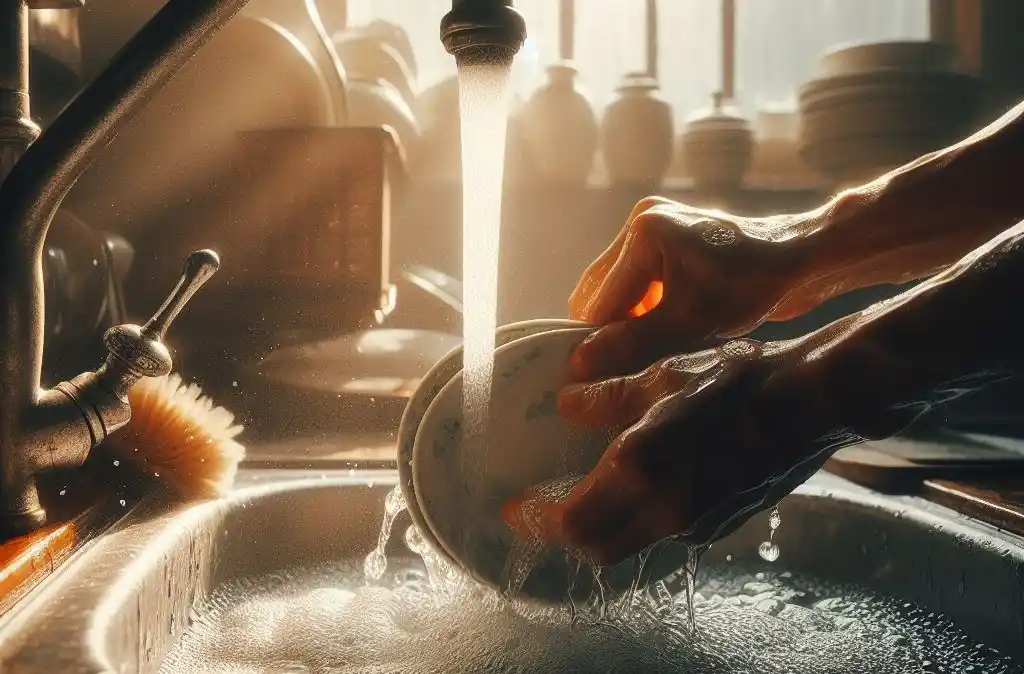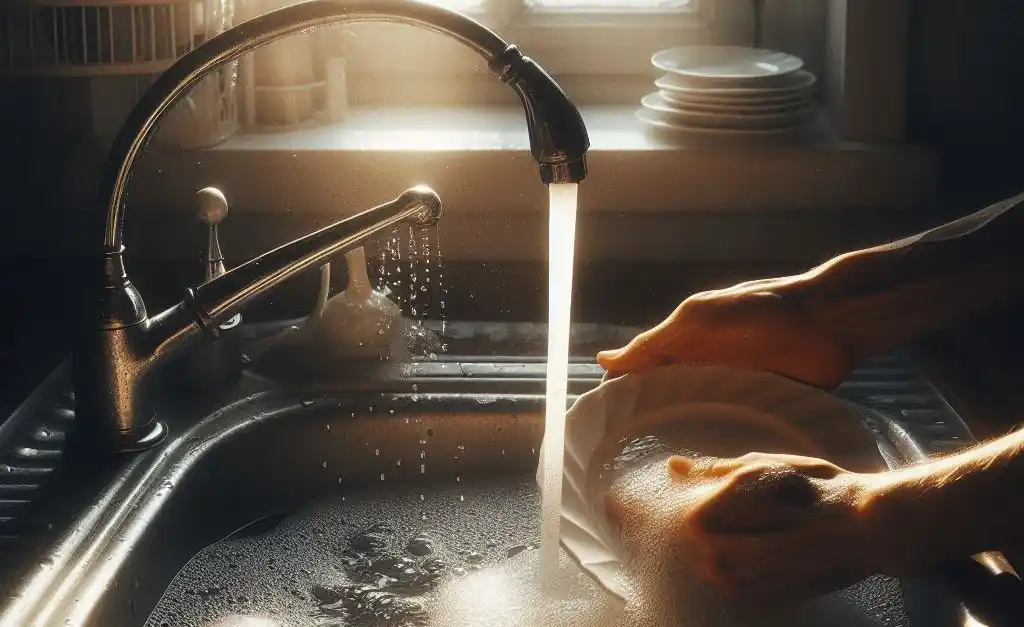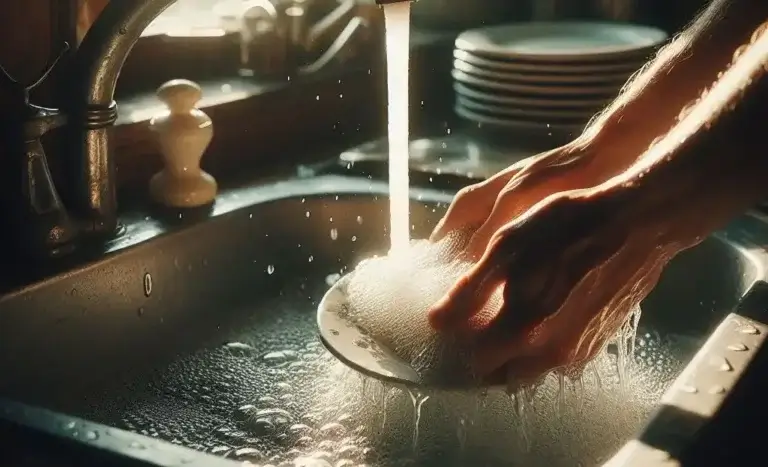How to Wash Dishes by Hand Properly Without a Dishwasher
Are you looking to learn how to wash dishes the right way? Washing dishes by hand can be tedious, but it doesn’t have to be difficult if you follow some simple tips.
This comprehensive guide will teach you the proper process of hand washing dishes so they get completely clean without wasting water or time. You’ll learn the best order to wash the dishes, how long to soak them, and what tools you need, plus over 20 tricks to get rid of grease and baked-on food easily.
Whether you don’t have a dishwasher or want to save money and energy by washing dishes by hand, this article will make sure your pots, pans, silverware, glasses, and delicate china sparkle every time. Let’s get started!
Table of Contents
Why Learn to Wash Dishes by Hand?
Here are some top reasons to learn proper dishwashing techniques:
- Saves money – No need to repair or run an energy-hogging dishwasher
- Conserves water – Hand washing uses less water than a dishwasher cycle when done correctly
- Makes dishes cleaner – Soaking and scrubbing get into crevices that the dishwasher miss
- Better for delicate items – Crystal, china, and cast iron should always be washed dishes
- More sanitary – Washing by hand with very hot water kills more germs
- Satisfying chore – Methodically washing each piece can be relaxing and meditative
How to Wash Dishes Step-By-Step

Follow this simple 12-step method for hand-washing dishes to get them sparkling clean every time:
Gather All Supplies
- Sink basin or tub for washing
- Empty basin, dish rack or towel for drying
- Heavy-duty rubber gloves
- Hot water
- Dish soap or detergent
- Sponges & scrub brushes
- Dish towels or paper towels
Step 1: Scrape and Rinse Dishes
Before washing dishes, always scrape plate waste and leftover food into the trash. Then place dishes directly in the sink and rinse with warm water to remove remaining loose particles. This keeps food from clogging drains.
Step 2: Fill Sink Basin With Hot Water
Plug the sink and fill the basin halfway with hot water, as hot as your hands can stand. Hot water melts grease for easier cleaning.
Step 3: Add Dish Soap
Put on gloves, then squirt a generous amount of concentrated dish soap into the water. Swish water with your hand to make suds. More suds = easier cleaning.
Step 4: Soak the Dishes
Place dishes into sudsy hot water and let soak for 5-15 minutes before washing. Soaking time varies depending on how dry or greasy dishes are. This loosens caked-on foods.
Step 5: Wash Each Piece Individually
Start washing! Using a sponge, dish cloth or brush, scrub each dish on all surfaces. Wash dishes from least greasy (glassware, bowls) to most greasy (pots and pans). Change the water when it gets cold or extremely dirty.
Step 6. Rinse Dishes Thoroughly
Rinse each dish under hot running water after washing, until all traces of food and soap residue are gone. Set rinsed items in the drying rack.
Step 7: Repeat Wash/Rinse Cycle if Needed
Check dishes in daylight for residual stuck-on food or grease. For problem pieces, soak again or re-wash and rinse while focusing on troubled spots.
Step 8: Dry Immediately
Either wipe dishes immediately with a clean dish towel or allow wet dishes to air dry in rack. Don’t let wet items sit, this spreads germs!
Step 9: Deal With Tricky Bakeware
Treat extra-messy items like cookie sheets separately. Sprinkle with baking soda and soak for faster cleaning, then wash as usual with soap and brush.
Step 10: Wash Sink & Accessories
When all dishes are washed, take off gloves and thoroughly clean the sink basin, drain racks, sponges and scrub brushes with hot soapy water. Rinse and wring out sponges and dishcloths, allowing them to dry before the next use. Replace frequently.
Step 11: Inspect Dishes in Daylight
Checking dishes in natural light reveals any overlooked stuck-on food bits. Re-wash anything with soil before putting dishes away.
Step 12: Store Cookware Properly
Before storing pots, pans, and utensils, make sure they are 100% dry to prevent rust or transfer of smells and tastes to other foods next usage.
15 Tips to Wash Dishes & Cookware Like a Pro!

Follow these handy shortcuts to learn how to wash dishes by hand faster and better than ever:
- Use very hot water – it melts grease and cuts cleaning time significantly
- Choose eco-friendly fragrance-free dish soap that cleans well in cold water too
- Alternate use of sponges and scrub brushes for maximum cleaning power
- Always hand wash cast iron pans to retain seasoning; dry immediately and rub with oil after rinsing
- Soak dishes before hand washing to loosen stuck food and make cleaning 60% easier
- Soak pots used for pasta, oatmeal or rice immediately since starch hardens when dry
- Fill a spray bottle with hot water/vinegar solution to help melt greasy buildup on certain pans
- Sprinkle tricky items like sheet pans with a heavy coating of baking soda while soaking for easy scouring
- Use specific cleaners made to dissolve coffee and tea stains on mugs
- Hand wash only crystal, china, nonstick, and antique items to prevent damage from high dishwasher heat
- Buy a double basin sink or bin tub to keep dirty wash water separate from clean rinse water
- Set up an efficient wash-rinse station by designating one side of the sink for washing, the other exclusively for rinsing
- Have two sets of dish draining racks – while one set air dries, the other catches newly washed pieces
- Always thoroughly dry hand-washed items immediately to inhibit bacteria growth and prevent water spots
- Clean dish towels after every use or swap for paper towels to avoid germ transference to “clean” dishes
Specialized Cleaning for Different Dishware
Delicate glassware, antique silver pieces and precious china and crystal should always be hand wash dishes, never cleaned in a high-heat dishwasher. Here are tips for manual washing of specialty dishware:
- Crystal – Wash gently with a soft sponge and non-abrasive cleaner; rinse and dry immediately with a soft towel
- China – Check manufacturer guidelines; typically hand wash only using mild dish soap in warm water
- Pewter – Use gentle liquid cleaner without bleach to preserve patina; rinse, dry, and buff gently with a microfiber cloth
- Cast Iron – Clean with a stiff brush and hot water only; towel dry immediately and re-season with a light coat of vegetable oil
- Nonstick Coated – Use a soft sponge with nonabrasive soap to avoid scratching coating
- Earthenware – Rub gently with a soft sponge and mild soap; do not soak porous clay material or allow water to stand on the surface
- Cutlery – Wash blades extra carefully with a soft sponge to avoid damaging and dulling edges
Amazing Cleaning Solutions for Extremely Dirty Dishes
Dealing with extremely greasy, grimy dishes or pots encrusted with burned food? These powerful potions will get them sparkling like new again:
- Baking Soda – For sheet pans with burnt bits, sprinkle soda generously on dried gunk and soak overnight before scrubbing clean. The alkali in baking soda dissolves cooked-on grease and residue.
- White Vinegar – Fill a spray bottle with straight distilled white vinegar to spritz on extra-greasy spots and pans before and during washing; doubles the cleaning power of dish soap.
- Denture Tablets – Drop two tablets into a bowl of hot water with soiled drinking glasses; tablets dissolve calcium deposits and tea/coffee stains while they soak.
- Cream of Tartar – Mix with baking soda and water into a thick paste and apply paste directly on stained cups and pots. Let set for 10 minutes before scrubbing. Removes staining beautifully!
Washing Machine Tips for Very Dirty Dishes & Pots
If washing an exceptionally tall stock pot or heavy commercial cookware by hand seems impossible, try using your washing machine! Yes, you can safely clean caked or burnt dishes in your laundry machine. Here’s how to do it:
- Remove loose food bits first by rinsing or soaking dishes
- Place extremely soiled items on the lowest and centermost rack of the dishwasher
- Wash alone or with extremely dirty towels using the hottest water possible
- Add 1-2 cups of distilled white vinegar to rinse for residue-free results
- Use the “Sanitize” setting and dry cycle for heat-dried dishes
- Remove promptly from the dryer and hand-dry any remaining moisture
This strategy can restore badly neglected dishes to a sanitary condition before doing final hand rinsing and cleaning.
Top Dishwashing Accessories & Tools
Having the right accessories makes washing dishes by hand infinitely easier.
Essential Tools:
- Heavy Duty Rubber Gloves – Protect hands from scalding water
- Double Sink Basin or Wash Tubs – Holds wash water separately from clean rinse water
- Bristle Brushes – Scrubs stuck particles off pots and pans
- Soft Sponges – For gently cleaning delicate glassware
- Terry Dish Towels – Extra absorbent for drying
- Slanted Dish Drainer – Allows dishes to air dry rapidly
Specialty Cleaners:
- Enzyme Soap – Removes protein/grease films
- Glass & Surface Cleaner – Prevents hard water spots on glassware
- Stainless Steel Cleaner – Restores luster and inhibits watermarks
- Silver Polish – Protects antique serving pieces
With the right accessories hand, hand-washing dishes is easier. Invest in heavy-duty rubber gloves to keep hands safe. A divided double sink basin allows you to keep dirty wash water separate. Use bristle brushes and soft sponges for scrubbing different dishware. Have plenty of super absorbent dish towels on hand for drying. A slanted drain board accelerates air drying. Specialty dish cleaners like enzyme soap, glass cleaner, stainless steel polish, and silver cleaner make the job more efficient.
FAQs: Hand Washing Dishes
Still, have questions about the best way to wash dishes without a dishwasher? Here are answers to some frequently asked questions:
What temperature water should I use to wash dishes?
As hot as possible! Heated water dissolves oil and grease better. Use gloves and test water temp with your hands first before submerging delicate skin or dishware.
What is the best dish soap for washing dishes by hand?
Concentrated gel formulas are most effective at grease-cutting, rinsing freely, and not leaving residue. Eco-friendly types work well too.
How much time does it take to wash dishes by hand?
The total average time is 30-60 minutes including scrapping, soaking, washing, rinsing, and drying dishes and cookware used by a family of four.
What should I use to scrub pans – sponge or brush?
For caked-on food, always use a stiff bristle brush first. Sponges are best for the gentle cleaning of delicate items.
Help! I have hard water stains on my glassware – how do I remove them?
Hard water deposit stains come off glassware by soaking in 50/50 vinegar and hot water solution for 15-30 minutes before washing.
Hand-washing dishes effectively takes some effort but pays off by conserving money, water, and energy. Following these tips for properly washing dishware by hand sans dishwasher will result in sparkling clean plates, utensils, and cookware every time!
In Conclusion
I hope this comprehensive guide has helped explain exactly how to wash dishes properly by hand from start to finish! Here’s a quick recap on proper dishwashing technique:
- Rinse all dishes first
- Fill the sink with hot sudsy water and soak dishes to loosen food
- Wash each piece individually with a sponge/brush
- Rinse every item under hot running water
- Dry dishes immediately
- Deal with extra-messy cookware separately
- Always wash the sink, towels, sponges, and brushes too
- Inspect all dishes in daylight before putting them away
Learning how to effectively wash dishes by hand without a dishwasher saves money, conserves water, helps the planet, and provides cleaner dishware for the whole family to enjoy squeaky clean meals!
Hope these tips have built your confidence in how to properly hand wash the dishes. Now relax and let your cleanly washed dishes air dry while you put your feet up!








